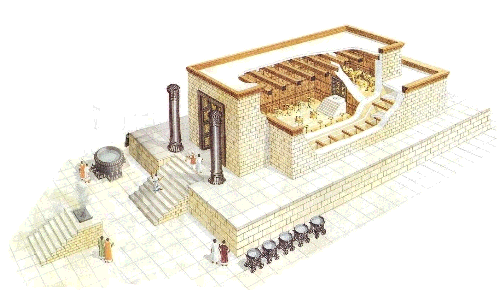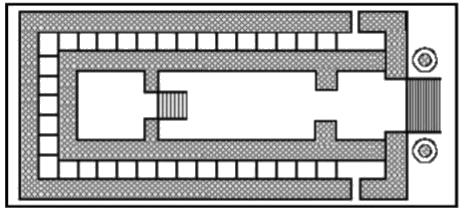
Illustration from the collection "L'Homme et son histoire",
tome 1 :
"Les premières civilisations", Édition du Club France Loisirs, Paris 1997.
Hiram & Salomon
The study of this episode on ancient history is made possible through two principal sources: the Old Testament, and the writings of the historian
Josephus(1) who lived in Israel during the first century of our era.
At the beginning of the tenth century BC, Hiram, succeeded his father Abibaal as the new king of Tyre. He worked on the development and prosperity of his city, by
expanding the two ports and connecting them via a canal which crossed the city. He erected new temples to Melqart and Astarte.
His activity did not fail to arouse the admiration of his neighbors and contemporaries, David and Solomon, the kings of Israel, with whom he consequently maintained a close
friendship, and trade links.
Wishing to offer a temple to his God, King David had contacted King Hiram for the preparations of this construction. Death has deprived David of his dream, so the
responsibility of carrying out this project was left to his son, King Solomon, who also had to turn to Hiram to provide him with cedar wood, and make available a team of
architects and masons from Tyre, in order to implement his purpose (see 1 Kings, Chapter 5).
And Solomon sent to Hiram, saying,
"Thou knowest how that David my father could not build an house unto the name of the LORD his God for the wars
which were about him on every side, until the LORD put them under the soles of his feet. But now the LORD my God hath given me rest on every side, so that there
is neither adversary nor evil occurrent. And, behold, I purpose to build an house unto the name of the LORD my God, as the LORD spake unto David my father, ...
Now therefore command thou that they hew me cedar trees out of Lebanon; and my servants shall be with thy servants: and unto thee will I give hire for thy servants
according to all that thou shalt appoint. For thou knowest that there is not among us any that can skill to hew timber like unto the Sidonians."
When Hiram heard the words of Solomon, that he rejoiced greatly, and said,
"Blessed be the LORD this day, which hath given unto David a wise son over this great people.
And Hiram sent to Solomon, saying, I have considered the things which thou sentest to me for: and I will do all thy desire concerning timber of cedar, and concerning timber of fir.
My servants shall bring them down from Lebanon unto the sea: and I will convey them by sea in floats unto the place that thou shalt appoint me, and will cause them to be discharged
there, and thou shalt receive them: and thou shalt accomplish my desire, in giving food for my household".
The pact between Hiram and Solomon was honored and continued for twenty years. Hiram supplied the builders and the cedar and juniper wood, and Solomon, in exchange sent to his
friend 20,000 Muids(2) of wheat and 20,000 virgin oil measures annually. Solomon also ceded twenty cities of Galilee. Historians report that Hiram
was not entirely satisfied, and then Solomon promised him a common expedition to Ophir, the mysterious country, in the quest of treasures in gold and precious stones.
The interior design of the temple was described in the Bible (see I Kings, Chapter 6) in those terms:
"
15. Salomon built the walls of the house within with boards of cedar: from the floor of the house to the walls of the ceiling. (...) He covered the floor of the house with boards of fir.
18. (...) All was cedar, there was no stone seen.
19. And he prepared an oracle in the midst of the house (...)
20. (...) and he overlaid it with pure gold. And he covered the altar with cedar.
22. The whole house he overlaid with gold, (...) also the whole altar that belonged to the oracle he overlaid with gold.
23. In the oracle he made two cherubim of olive wood, each ten cubits high.
24. Five cubits was the one wing of the cherub, and five cubits the other wing of the cherub: from the uttermost part of the one wing to the uttermost part of the other were ten cubits(...).
28. He overlaid the cherubim with gold.
29. He carved all the walls of the house around with carved figures of cherubim and palm trees and open flowers, inside and outside.
30. The floor of the house he overlaid with gold, inside and outside. (...)
38. (...) So was he seven years in building it".
The Temple of Jerusalem
Built by the architects and contractors of Tyre

(according to Professor D. Harden)
A monumental gate framed by two bronze columns(3) provided access to the temple, preceded by a large courtyard with a basin with lustral
waters and an altar. The plan presented on the inside a succession of three pieces: a square vestibule, a central rectangular room with a gold-covered altar and a sacrificial table,
and the last section was a sanctuary to set the ark of Alliance. The building was completed with service rooms located all around over three floors.
Hiram, the Master Mason:
We cannot talk of Solomon's temple without evoking another Huram (or Hiram), the Phoenician bronze sculptor or master mason. Between legend and historical truth, the story
of the master Hiram remains rather enigmatic. The Book of Kings (I Kings, Chapter VII, 13-45) presents it in these terms:
"King Solomon sent to Tyre and brought Huram, whose mother was a widow from the tribe of Naphtali and whose father was from Tyre and a skilled craftsman in bronze.
(...) Huram finished all the work he had undertaken for King Solomon in the temple of the Lord. the two pillars(4), the two bowl-shaped capitals
on top of the pillars, the two sets of network decorating the two bowl-shaped capitals on top of the pillars, the four hundred pomegranates for the two sets of network - two rows
of pomegranates for each network - decorating the bowl-shaped capitals on top of the pillars, the ten stands with their ten basins, the Sea and the twelve bulls under it, the pots,
shovels and sprinkling bowls and all other accessories.
That Hiram made for King Solomon for the temple of the Lord were of burnished bronze."
Another passage from the Bible (II Chronicles - Chapter 2: 3-14) also evokes the history of the master Hiram:
"Solomon sent word to Hiram the king of Tyre (...) Send me, therefore, a man skilled to work in gold and silver, bronze and iron, and in purple, crimson and blue yarn, and experienced
in the art of engraving, to work in Judah and Jerusalem with my skilled workers, whom my father David provided. (...) Then Hiram the king of Tyre answered (...) Now I have sent a skilled man,
who has understanding, Huram-abi, the son of a woman of the daughters of Dan, and his father was a man of Tyre. He is trained to work in gold, silver, bronze, iron, stone, and wood, and in purple,
blue, and crimson fabrics and fine linen, and to do all sorts of engraving and execute any design that may be assigned him."
As for legend, it is said that Hiram worked for seven years in building the temple. His workers were divided into three classes: apprentices, journeymen and masters. Each class had
a password allowing its members to receive a gradual salary.
Work nearing completion, three companions, eager to be assigned master privileges, posted themselves in front of each door of the temple. The first asked the master for the password,
who replied that it was not possible to get it this way and that he should have the patience to wait for the right moment. Then the companion beats the architect brutally on his neck
using a ruler - that wound symbolizes the physical death of Hiram. The second companion, who got the same answer, dealt a powerful bracket blow on the left breast of the master - it's the
sentimental death. Groggy, Hiram walked towards the third door and was confronted by the last companion who asked him the same question. The mallet blow ended the agony of Hiram - this third
death corresponds to the mental death of the architect. Then the murderers reciprocally asked for the master's word, none of them was able to obtain this password. Realizing that their crime
was useless, they buried Hiram and planted in this place an acacia branch, the tree of life, through which the envoys of Solomon were able to find the body of the master.
This legend strongly marks the Masonic symbolism through its three classes: apprentices, journeymen and masters. The accession to the master grade, the symbolic death, repeats
the steps of the murder of Hiram, the latter symbolizing the just and righteous man killed because of ignorance. Thus, in the Masonic ritual, the recipient is covered with a black sheet
on which is placed a branch of acacia. To the question: "Are you a master?" The initiate must enunciate the ritual phrase "the acacia known me"
(5).
| (1) |
Flavius Josèphe se référa aux célèbres historiens Dios et Ménandre qui, de leur côté, travaillèrent directement sur les archives de la ville, les fameuses Chroniques tyriennes. |
Retour texte |
| (2) |
Le muid vaut 365 litres. |
Retour texte |
| (3) |
Les deux colonnes sont les copies des deux piliers situés devant le temple de Melqart à Tyr : les fameux Jakin et Boaz (les colonnes J:. et B:. que l'on retrouve à l'entrée de plusieurs temples maçonniques). |
Retour texte |
| (4) |
Les deux colonnes sont les copies des deux piliers situés devant le temple de Melqart à Tyr : les fameux Jakin et Boaz (les colonnes J:. et B:. que l'on retrouve à l'entrée de plusieurs temples maçonniques). |
Retour texte |
| (5) |
Cf.,le Magazine L'Histoire, n° 256, Juillet-Août 2001, Spécial, Les Francs-Maçons, p.11. |
Retour texte |

